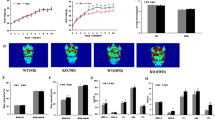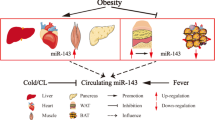Abstract
Defects in insulin signalling are among the most common and earliest defects that predispose an individual to the development of type 2 diabetes1,2,3. MicroRNAs have been identified as a new class of regulatory molecules that influence many biological functions, including metabolism4,5. However, the direct regulation of insulin sensitivity by microRNAs in vivo has not been demonstrated. Here we show that the expression of microRNAs 103 and 107 (miR-103/107) is upregulated in obese mice. Silencing of miR-103/107 leads to improved glucose homeostasis and insulin sensitivity. In contrast, gain of miR-103/107 function in either liver or fat is sufficient to induce impaired glucose homeostasis. We identify caveolin-1, a critical regulator of the insulin receptor, as a direct target gene of miR-103/107. We demonstrate that caveolin-1 is upregulated upon miR-103/107 inactivation in adipocytes and that this is concomitant with stabilization of the insulin receptor, enhanced insulin signalling, decreased adipocyte size and enhanced insulin-stimulated glucose uptake. These findings demonstrate the central importance of miR-103/107 to insulin sensitivity and identify a new target for the treatment of type 2 diabetes and obesity.
This is a preview of subscription content, access via your institution
Access options
Subscribe to this journal
Receive 51 print issues and online access
$199.00 per year
only $3.90 per issue
Buy this article
- Purchase on Springer Link
- Instant access to full article PDF
Prices may be subject to local taxes which are calculated during checkout




Similar content being viewed by others
References
Kahn, C. R. Knockout mice challenge our concepts of glucose homeostasis and the pathogenesis of diabetes. Exp. Diabesity Res. 4, 169–182 (2003)
Taniguchi, C. M., Emanuelli, B. & Kahn, C. R. Critical nodes in signalling pathways: insights into insulin action. Nature Rev. Mol. Cell Biol. 7, 85–96 (2006)
Muoio, D. M. & Newgard, C. B. Mechanisms of disease: molecular and metabolic mechanisms of insulin resistance and β-cell failure in type 2 diabetes. Nature Rev. Mol. Cell Biol. 9, 193–205 (2008)
Bartel, D. P. MicroRNAs: target recognition and regulatory functions. Cell 136, 215–233 (2009)
Krützfeldt, J. & Stoffel, M. MicroRNAs: a new class of regulatory genes affecting metabolism. Cell Metab. 4, 9–12 (2006)
Herrera, B. M. et al. Global microRNA expression profiles in insulin target tissues in a spontaneous rat model of type 2 diabetes. Diabetologia 53, 1099–1109 (2010)
Anderson, N. & Borlak, J. Molecular mechanisms and therapeutic targets in steatosis and steatohepatitis. Pharmacol. Rev. 60, 311–357 (2008)
Krützfeldt, J. et al. Silencing of microRNAs in vivo with ‘antagomirs’. Nature 438, 685–689 (2005)
Esau, C. et al. MicroRNA-143 regulates adipocyte differentiation. J. Biol. Chem. 279, 52361–52365 (2004)
Kajimoto, K., Naraba, H. & Iwai, N. MicroRNA and 3T3–L1 pre-adipocyte differentiation. RNA 12, 1626–1632 (2006)
Ortega, F. J. et al. MiRNA expression profile of human subcutaneous adipose and during adipocyte differentiation. PLoS ONE 5, e9022 (2010)
Sun, T., Fu, M., Bookout, A. L., Kliewer, S. A. & Mangelsdorf, D. J. MicroRNA let-7 regulates 3T3–L1 adipogenesis. Mol. Endocrinol. 23, 925–931 (2009)
Xie, H., Lim, B. & Lodish, H. F. MicroRNAs induced during adipogenesis that accelerate fat cell development are downregulated in obesity. Diabetes 58, 1050–1057 (2009)
Goossens, G. H. The role of adipose tissue dysfunction in the pathogenesis of obesity-related insulin resistance. Physiol. Behav. 94, 206–218 (2008)
Yamauchi, T. et al. The fat-derived hormone adiponectin reverses insulin resistance associated with both lipoatrophy and obesity. Nature Med. 7, 941–946 (2001)
Rothberg, K. G. et al. Caveolin, a protein component of caveolae membrane coats. Cell 68, 673–682 (1992)
Nystrom, F. H., Chen, H., Cong, L. N., Li, Y. & Quon, M. J. Caveolin-1 interacts with the insulin receptor and can differentially modulate insulin signaling in transfected Cos-7 cells and rat adipose cells. Mol. Endocrinol. 13, 2013–2024 (1999)
Yamamoto, M. et al. Caveolin is an activator of insulin receptor signaling. J. Biol. Chem. 273, 26962–26968 (1998)
Otsu, K. et al. Caveolin gene transfer improves glucose metabolism in diabetic mice. Am. J. Physiol. Cell Physiol. 298, C450–c456 (2009)
Cohen, A. W. et al. Caveolin-1-deficient mice show insulin resistance and defective insulin receptor protein expression in adipose tissue. Am. J. Physiol. Cell Physiol. 285, C222–C235 (2003)
Cohen, A. W., Combs, T. P., Scherer, P. E. & Lisanti, M. P. Role of caveolin and caveolae in insulin signaling and diabetes. Am. J. Physiol. Endocrinol. Metab. 285, E1151–E1160 (2003)
Parton, R. G. & Simons, K. The multiple faces of caveolae. Nature Rev. Mol. Cell Biol. 8, 185–194 (2007)
Semple, S. C. et al. Rational design of cationic lipids for siRNA delivery. Nature Biotechnol. 28, 172–176 (2010)
Hansen, L. H., Madsen, B., Teisner, B., Nielsen, J. H. & Billestrup, N. Characterization of the inhibitory effect of growth hormone on primary preadipocyte differentiation. Mol. Endocrinol. 12, 1140–1149 (1998)
Tozzo, E., Shepherd, P. R., Gnudi, L. & Kahn, B. B. Transgenic GLUT-4 overexpression in fat enhances glucose metabolism: preferential effect on fatty acid synthesis. Am. J. Physiol. 268, E956–E964 (1995)
Minehira, K. et al. Blocking VLDL secretion causes hepatic steatosis but does not affect peripheral lipid stores or insulin sensitivity in mice. J. Lipid Res. 49, 2038–2044 (2008)
Preitner, F., Mody, N., Graham, T. E., Peroni, O. D. & Kahn, B. B. Long-term Fenretinide treatment prevents high-fat diet-induced obesity, insulin resistance, and hepatic steatosis. Am. J. Physiol. Endocrinol. Metab. 297, E1420–E1429 (2009)
Acknowledgements
We would like to thank F. Preitner and B. Thorens for the hyperinsulinaemic euglycaemic clamp studies. M.T. was supported by a fellowship from the Juvenile Diabetes Research Foundation International. The work was supported in part by the Swiss National Science Foundation (SNF, LiverX), the European Community (SIROCCO, ERC and MetaboloMirs) and the Leducq Foundation.
Author information
Authors and Affiliations
Contributions
M.T. and M.S. designed the experiments. M.T. performed the experiments and conducted the data analysis. J.H. and M.Z. performed the bioinformatic analysis. M.H.H. provided liver samples and participated in analysis of clinical data. B.B. synthesized antagomirs. A.A. provided liposomal formulations. M.T. and M.S. wrote the paper with input from all co-authors.
Corresponding author
Ethics declarations
Competing interests
The authors declare no competing financial interests.
Supplementary information
Supplementary Information
The file contains Supplementary Tables 1-2 and Supplementary Figures 1-9 with legends. (PDF 930 kb)
Rights and permissions
About this article
Cite this article
Trajkovski, M., Hausser, J., Soutschek, J. et al. MicroRNAs 103 and 107 regulate insulin sensitivity. Nature 474, 649–653 (2011). https://doi.org/10.1038/nature10112
Received:
Accepted:
Published:
Issue Date:
DOI: https://doi.org/10.1038/nature10112
This article is cited by
-
Identification of HDAC9 and ARRDC4 as potential biomarkers and targets for treatment of type 2 diabetes
Scientific Reports (2024)
-
Metabolic memory: mechanisms and diseases
Signal Transduction and Targeted Therapy (2024)
-
Cardiovascular complications of diabetes: role of non-coding RNAs in the crosstalk between immune and cardiovascular systems
Cardiovascular Diabetology (2023)
-
Glucose metabolism after bariatric surgery: implications for T2DM remission and hypoglycaemia
Nature Reviews Endocrinology (2023)
-
Non-coding RNAs in human health and disease: potential function as biomarkers and therapeutic targets
Functional & Integrative Genomics (2023)
Comments
By submitting a comment you agree to abide by our Terms and Community Guidelines. If you find something abusive or that does not comply with our terms or guidelines please flag it as inappropriate.



